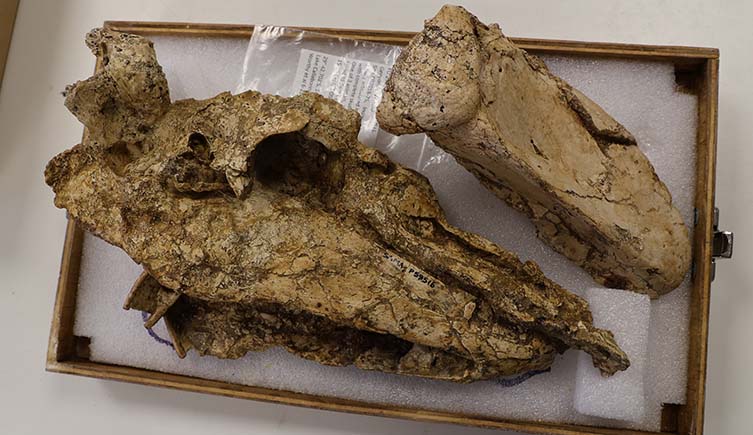After more than a century of searching, the head of one of the largest ever birds has been found.
Nicknamed the ‘giga-goose’, the newly uncovered skull provides a detailed insight into how Genyornis newtoni lived.

The newly-discovered skull of Genyornis newtoni has allowed its head to be accurately reconstructed for the first time. Image © Jacob C. Blokland, used with permission.
After more than a century of searching, the head of one of the largest ever birds has been found.
Nicknamed the ‘giga-goose’, the newly uncovered skull provides a detailed insight into how Genyornis newtoni lived.
The face of a giant flightless bird has been reconstructed tens of thousands of years after it was last seen by humans.
Living more than 45,000 years ago, Genyornis newtoni would have been one of the many large animals, or megafauna, living in ancient Australia. Standing over two metres tall and weighing up to 240 kilogrammes, it would have been an imposing presence for the first humans to reach the continent.
Shortly after humans arrived, however, Genyornis went extinct. The birds are thought to have been eaten into extinction, with climate change hastening their demise. Their extinction was so rapid that only one poorly preserved skull was thought to have survived, leaving much to learn about this enormous bird.
Now, 128 years after Genyornis was first found, scientists have been able to put a face to the name. Phoebe McInerney, a PhD student who led the study, says that new skull fossils have revealed the species is not the bird they had expected.
“The exact relationship of Genyornis with waterfowl has been complicated to unravel,” Phoebe says. “We have started to piece together the puzzle with this new skull which shows, simply put, that this species is a giant goose.”
“While its upper jaw is tall and mobile, like that of a parrot, it’s shaped like a goose. With a wide gape and strong bite force, Genyornis would have had the ability to crush soft plants and fruit on the roof of their mouth.”
The paper was published in the journal Historical Biology.

The Genyornis newtoni skull was uncovered from Lake Callabonna. Image © McInerney et al. 2024.
While Genyornis was first named in 1896, it would be another 17 years before a skull was found. But when the head was described, the researchers noted that it “had suffered such great distortion from pressure affecting it laterally that anything approaching a satisfactory reconstruction was quite impossible”.
As is the case in many fossils, the fragility of the skull means it’s often either destroyed or poorly preserved by the process of fossilisation. This is an issue, as skulls can often reveal a lot of information about an animal’s diet, appearance and even behaviour. As a result, many questions continued to hang over Genyornis’ exact role in the environment and place in the tree of life.
The birds are the last of the mihirungs, a group of giant flightless birds that inhabited Australia for over 20 million years, but their closest relatives have remained uncertain. Originally considered to be a relative of ostriches, more recent research instead suggested these animals are close relatives of either ducks or chickens.
Ultimately, the best way to settle these questions was to discover a well-preserved skull. This took researchers to Lake Callabonna, a salt lake in South Australia where the first Genyornis fossils were found.
“Lake Callabonna is constantly being eroded by the wind, blowing away the top layer of sand to reveal the articulated fossils of complete individuals which were buried in the clay thousands of years ago,” Phoebe says. “There are so many skeletons that we knew we would find something when we went out, but uncovering a skull was one of our top priorities.”
“We couldn’t just wait for a Genyornis head to appear, however, as exposed bones turn to dust and are blown away. It was so exciting that we were able to get there in time and bring this skull back to the lab.”

The researchers found that the closest living relative of Genyornis newtoni is the horned screamer, Anhima cornuta. Image © Phoebe McInerney, used with permission.
In total the team retrieved one relatively complete Genyornis skull, as well as fragments from five others. They revealed that the bird had a relatively large head with big jaws, allowing the animals to eat a wide range of fruit and other plants.
The skull was also topped by a triangular casque, a bony structure which grows out of the skull and is covered in a hard layer of skin. This means Genyornis is the only mihirung known to have one, with the researchers suggesting it might have been used to attract potential mates.
Despite living in relatively dry regions, the skull shows that Genyornis was well-suited for aquatic habitats. As a relative of ducks and geese, it still had adaptations that would have prevented its ears and throat from filling with water when the head was submerged.
The paper suggests that these adaptations might be a sign that the bird was already struggling before the arrival of humans. Changing climate patterns meant that wet areas like Lake Callabonna started getting drier around 60,000 years ago and dried up completely 12,000 years later.
There are indications that the legs of Genyornis were gradually adapting to this drier climate, but the species would have remained under considerable pressure. This environmental stress is thought to be why the birds had higher than expected levels of bone disease at around the same time.
This pressure on the birds would only have risen when humans arrived, with previous research showing that the first Australians stole and ate the eggs of Genyornis. Together, these factors were enough to drive the species into extinction, ending a lineage that had lasted for tens of millions of years.
The researchers hope that the discovery of more fossils and more in-depth analyses will reveal more about the history of the last of the mihirungs, and how they relate to birds more widely.

We're working towards a future where both people and the planet thrive.
Hear from scientists studying human impact and change in the natural world.
Don't miss a thing
Receive email updates about our news, science, exhibitions, events, products, services and fundraising activities. We may occasionally include third-party content from our corporate partners and other museums. We will not share your personal details with these third parties. You must be over the age of 13. Privacy notice.
Follow us on social media